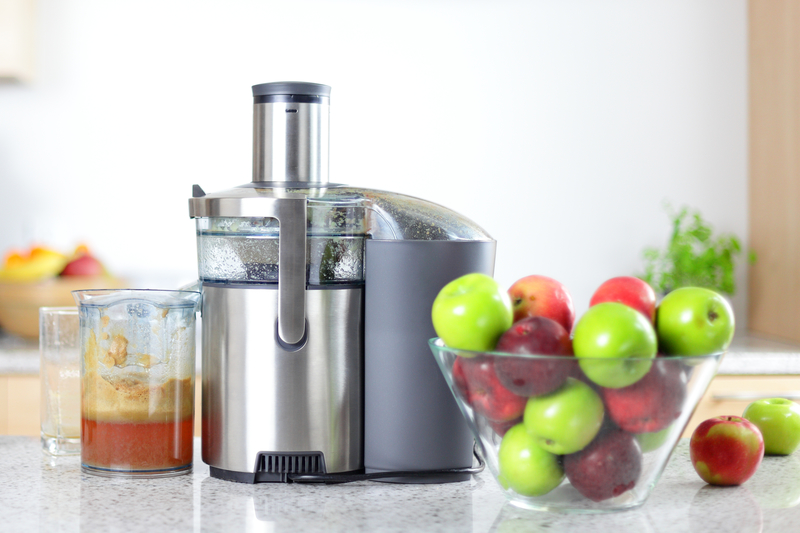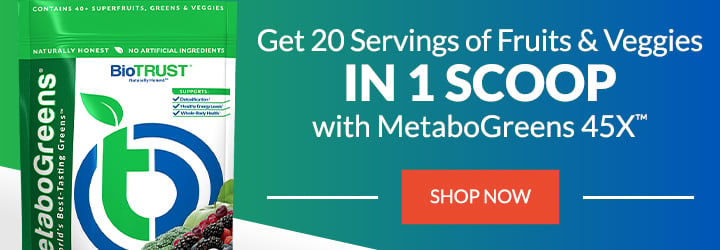Juicing vs. Blending: What’s Better for Your Health?

You probably know you need to eat more vegetables and fruit. After all, according to the Centers for Disease Control and Prevention (CDC), a mere 1 in 10 adults gets the recommended amount of 2 to 3 cups of vegetables and 1 ½ to 2 cups of fruits per day. 1 This is a key reason why both juicing and blending has become so attractive. Both juicing and blending make it easy to increase (sometimes dramatically so) your intake of veggies and fruits.
But when it comes to juicing vs. blending, what’s the difference, and which one is better for your health?
Vegetables and Fruits: What Are They Good for?
Getting enough vegetables and fruits is good for you. Hard stop. That’s not just according to your mom or grandmother either; countless studies have validated this. Of course, there is some debate over which vegetables or fruits are “best” (carrots vs. spinach or the benefits of nightshades, for example), but let’s be honest, most people need to eat more produce—period. Once you’ve consistently nailed that habit, then you can worry about which vegetable has the most carotenoids. In general, getting five or more servings of vegetables and fruits (more vegetables than fruits) daily has been shown to:
- Decrease the risk of strokes 2
- Reduce the risk of dying from cardiovascular disease 3
- Reduce the risk of all-cause mortality (i.e., death from all causes) 3
- Delay the onset of Alzheimer’s 4
- Lower blood pressure 5
- Prevent some types of cancer 6, 7, 8
- Improve digestion 9
- Reduce the risk of diabetes 10
- Promote eye health and vision 11
Now that we’ve reviewed how important it is to make sure you’re consuming the daily recommended amount of vegetables and fruits—at a minimum—let’s dig into juicing vs. blending.
What are the Benefits and Drawbacks of Juicing?
First contender into the juicing vs. blending bout is juicing.
First off, when we’re talking about juice, we are not talking about those cartons of fruity beverages available at every grocery or convenience store. Even when made up of mostly liquified fruits (more than you’d guess are actually water and chemical concoctions or “flavor packs” 13), store-bought fruit juice is loaded with a big, concentrated shot of sugar (often added sugar to boot) and preservatives.
So, what do we mean by juicing? It’s when you grab a few handfuls or cups of fresh vegetables along with some fruit (I recommend a maximum of about a half cup to a cup of fruit) and use a machine to separate out the fiber and pulp, leaving you with a concentrated source of the vitamins, minerals, and phytonutrients (the natural plant chemicals that give veggies and fruits their vibrant colors and powerful antioxidant properties).
Centrifugal juicers are the most common type. With a fast-spinning metal blade and a mesh filter, the juice is pulled away from the flesh and then separated into different sections. There’s typically a spout for the juice to spill out into your glass as well as a container for the fiber (which you can use in other recipes, like soups or muffins, or to enrich your compost pile).
While these are the most common and typically more affordable, there are concerns because the blade can get hot, and heat can potentially oxidize the delicate nutrients and destroy some of the enzymes found in your vegetables and fruits.
Masticating or cold-press juicers, on the other hand, first crush the vegetables and then press out the liquid, typically providing more juice than centrifugal juicers when using the same amount of produce. Because no heat is produced, it’s believed that masticating juicers also leave more nutrients intact.
There are other types available, and the prices vary greatly.
At the end of the day, when you juice (with any type of juicer), you’re left with a thin, highly concentrated shot of juice packed with readily absorbed nutrients (sans the fiber). The serving size is ideally small as calories can add up quickly from the sugars found naturally in vegetables and fruits—especially fruits. And too much sugar, especially without fiber, is still too much sugar, and it can have nasty effects on metabolic and overall health over time.
In addition, juicing can be expensive. You not only have to invest in the equipment, but you’ll also purchase a larger amount of produce. And if you get in the habit of visiting your local juice shop to get your fix, at $5 – 10 a pop (or more), that can add up very quickly.
In short, the benefits of juicing include:
- High nutrient density
- Helps increase the consumption of vegetables and fruits
- Increases the absorption of nutrients
- Can increase the variety of vegetables and fruits you consume
- MUCH Better alternative to store-bought juice
The drawbacks, on the other hand, include:
- Expensive equipment
- Removal of fiber and other nutrients found in the pulp
- Not as filling or satiating as blending or eating whole vegetables and fruit
- Uses more produce which can increase the costs
- Can be high in sugar
- Clean up can be a pain in the butt
- Can be wasteful
What are the Benefits and Drawbacks of Blending?
When you blend up vegetables and fruits (often with some ice and perhaps some protein powder, yogurt, nuts, seeds, or MCTs as a smoothie), what you put into the blender is what comes out—including the fiber and pulp, leaving you with a much larger, more satisfying serving size.
While the nutrient concentration (e.g., vitamins and minerals) may be less than when juicing, you will likely end up with higher amounts of phytochemicals and antioxidants as these nutrients are found primary in the fiber. 12 Plus, the process of blending helps break down the thick plant cell walls (i.e., cellulose) and helps release some of the nutrients that are often trapped within the fibrous cellulose.
Because you retain the fiber with blending, smoothies help you feel fuller, longer and support better digestive health. And because you can so easily add protein and healthy fats, it’s easy to whip up a nutrient-dense “meal replacement” you can enjoy for breakfast, after a workout, or when you’re on the run.
As long as you already have a blender, you don’t need to buy any special equipment—though blenders come in a wide variety of prices and quality, ranging from high-end, extremely powerful and durable blenders like the Vitamix® to much cheaper (and dramatically less powerful) personal blenders.
In short, the benefits of blending include:
- All of the nutrition vegetables and fruits have to offer, including the fiber
- Helps increase the consumption of vegetables and fruits
- Can add protein and healthy fats (via nuts, seeds, coconut oil, or MCTs, for example) for a nutrient dense drinkable “meal”
- Filling and satiating
- Can serve as a meal replacement
- Wide variety of flavor combinations
The drawbacks, on the other hand, include:
- Unappetizing texture for some people
- Can be very high in sugar, especially when adding lots of fruit
- Can be very calorie dense
Tips for Juicing or Blending
There are benefits to both juicing vs. blending—so why not do both? You’re bound to get some serious added nutrition.
A few tips to keep in mind:
- Limit the amount of fruits in your juice or smoothie to just a serving or two to avoid too much sugar.
- Load up on green leafy vegetables like spinach, kale, cabbage, and even parsley. Even in a smoothie, you’ll find their flavors are not overly strong.
- Cut the bitter taste of certain vegetables with peeled citrus fruits.
- When juicing, add plenty of water-rich vegetables like cucumbers, celery, Chinese cabbage (bok choy), and sweet peppers with some water-rich fruits like watermelon, oranges, or raspberries.
- When juicing, invest in a high-quality juicer, preferably cold-press. Same goes for a blender—invest in a high-quality blender, especially if you plan to use it frequently. When you go cheap, you often end up buying twice (or more).
- When possible, drink your juice or smoothie when it’s freshly made (e.g., within 15 minutes of making it) as some nutrients can be oxidized by light, heat, and air. If you’re making it ahead of time, keep it cool (e.g., in the fridge, freezer) in a dark, airtight container.
- Enjoy a rainbow of colorful vegetables and fruits instead of focusing on one or two favorites. Consume everything from leafy greens to a variety of peppers to cauliflower to vibrant-colored carrots. The colors of fruits and vegetables indicates their range of nutrients—and even the white ones contain important phytonutrients.







